Domus transforms a baroque palazzo into an experimental design laboratory
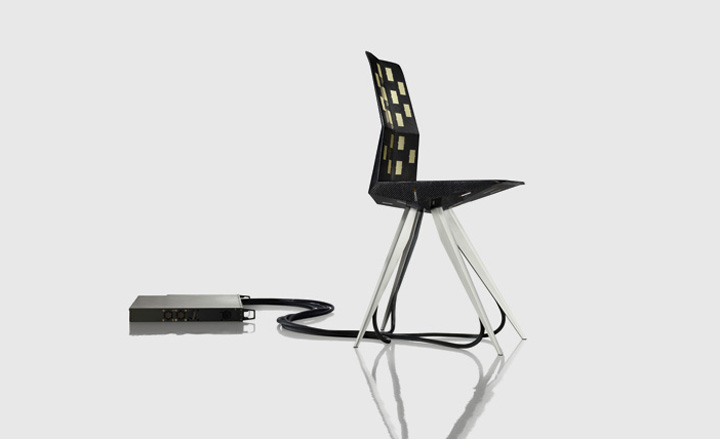
You could hardly miss the posters plastered all over Milan at this year's Salone del Mobile for Domus magazine's 'Future in the Making' exhibition. During the fair, Italy's foremost design and architecture magazine transformed the baroque Palazzo Clerici in the town centre into a 'transient laboratory of advanced experimentation and production'.
The curator Joseph Grima is Domus' newest editor-in-chief and this show is a reflection of his agenda to raise the level of discourse regarding 'the revolution that is radically changing the face of design'. New economic models, crowdfunding, microlaboratories, accessible technology and design, and above all sharing are all powering this 'glocal' phenomenon.
One of the main highlights of the show was a stress-test lab for the R18 Ultra Chair by designers Reed Kram and Clemens Weisshaar, who have been collaborating with car manufacturer Audi's ultra lightweight technology department. Visitors were asked to act as participants in data collection for the chair, constructed from high strength aluminium alloy, carbon fibre and a new carbon rubber compound, by sitting on it. The aim being: to implement the optimum materials for each component in a chair design with the high tech precision of a racing car.
Elsewhere in the exhibition, the emphasis was on projects that integrated sophisticated technology with a kind of garden shed ingenuity. It showed projects sharing high technology with the world via the web, allowing access to designs and low-cost hardware so DIY buffs from Chile to Adelaide can take up the design baton.
Thus a 14 year old boy in Chile, Sebastián Alegría, came up with an effective and cheap earthquake advanced warning system that works via Twitter based on a piece of open-source hardware called an Arduino. German designer Markus Keyser showed his SolarSinter machine that can generate objects and vessels out of desert sand using solar energy. And the old Dutch design masters Droog introduced an interesting concept for an alternative furniture fair that was based on a new economic model that would tax materials and waste rather than income.
As often happens with exhibitions that seek to document today's phenomena, it is hard to transmit the neatness or ingenuity of some of these conceptual and multimedia projects in a succinct way to a visually obsessed public with a short attention span, so much of the explanatory information required further research on the part of the visitor via the net and articles in the magazine. Nevertheless this was an important and most necessary contribution to the world's largest design fair that is still primarily driven by the blinkered and breakneck cycle of compulsive consumption.
We caught up with Domus editor and exhibition curator Joseph Grima to find out the aim of the show and what he hopes will be its legacy...
You worked for three years at the Storefront for Art and Architecture gallery in New York before being made Editor of Domus a year ago and now you are curating an exhibition here in Milan. Was the medium of the exhibition something you wanted to bring to Domus?
To some extent yes. I worked as an editor at Domus before, so took a lot of my editorial experience into running a gallery and now I am bringing the event-making experience back to the magazine. It is a way of giving a physical dimension to the making of a magazine. It's almost like making an article in 3D.
Do you see this as part of the need for publishing in general to move into different formats and disciplines?
Absolutely. We are living in an experience economy, which is more than simply reading words on paper, it's about creating a platform, a deep environment and a community. I think that's what Domus has always been: a nexus and focal point for a global community - connecting disciplines and exploring avant gardes. And the way you do that today is very different from how it was done 30 years ago.
What inspired the exhibition?
Last year we noticed an interest in open source as a model for the economy of design. We published a manifesto for open source architecture and it became quite a powerful statement. So we began to identify with this idea and decided to try and bring together a group of people who are working on this theme.
How would you describe the core ideas behind your exhibition?
The exhibition is an attempt to explore one of the emergent themes in design from architecture to urbanism, product design and so on. It is about collaborative rather than competitive practice. It is about sharing ideas and how new communication platforms have transformed the way we think about the design process. Above all it is about looking beyond the aesthetic appearance of the object as a measure of its value to the way it is made and the processes behind it - and the involvement of the user in the design process. It is about trying to take a snapshot of the profoundly altered relationships in the traditional triangle of manufacturer-designer-consumer. We are looking at how this top-down hierarchy is being replaced by a much more bottom-up idea of working with the end users rather than just pushing products at them.
What kind of messages do you hope to get across?
We are recognising the increasing importance of the maker movement as something that can't be ignored by the design community any longer. In the past people of tended to look down their noses at this rather informal group. We are trying to create a bridge between that and the top down, elitist design establishment that Milan represents. We wanted to officially bring the fablab world into the Salone.
Our second aim was to conduct an experiment. This baroque palace interior represents a time when architecture was more symbolic than anything else. Its formality is a complete removal from the world of production and hands-on artisans. It is anything but a workshop: If you can make furniture here you can make it anywhere.
So are you being rather revolutionary by turning a palace into a factory?
Yes, we are trying to be subversive but without actually burning the house down.
Some of these new design experiments and concepts are pretty hard to grasp. Is actually communicating the relevance of these projects the hardest part of a show like this - especially in such a visually dominated society as ours?
I think we need to work on multiple platforms. There are articles in this months issue of the magazine and we have a lot on the website as well as the exhibition. So we are trying to give ourselves an agenda and therefore attacking the problem from multiple angles. So much money is spent at the Salone. You can use that money for 'fireworks' and canapés, or you can use it to try and bring people together. Part of the function here is to round up a specific group of people that we have identified over several months of research and actually stick them in a building together and just see what happens. I think a lot of new collaborations can be born from this exhibition that could help move the whole discourse forwards.
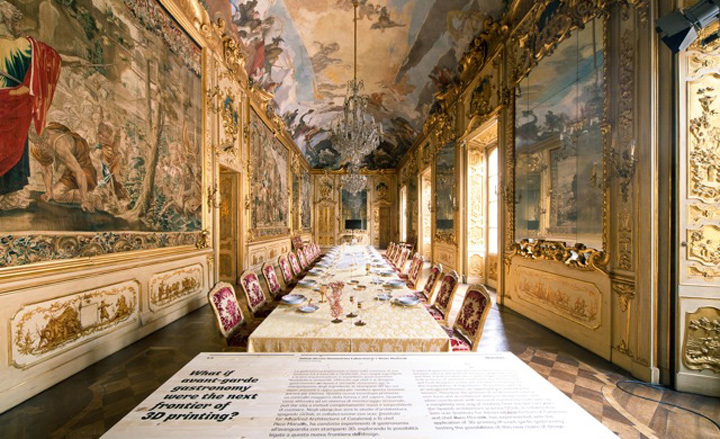
José Ramon Tramoyeres of Spainsh architects GGLab teamed up with chef Paco Morales for an exploration of the application of 3D printing in avant-garde gastronomy in the Tiepolo Room of the Palazzo Clerici
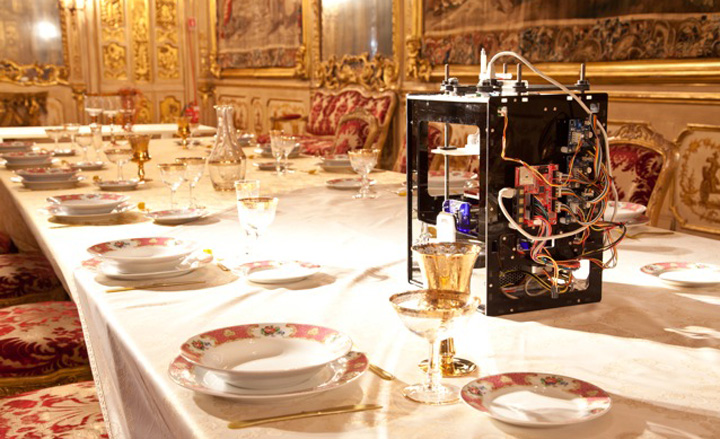
GGLab's food printing machine
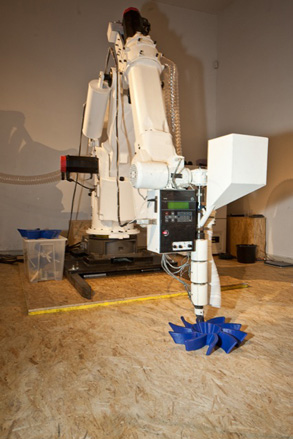
Eindhoven graduate Dirk Vander Kooij reprogrammed a borrowed industrial robot to self-manufacture furniture from recycled plastic by squeezing it like toothpaste out of a tube into pre-programmed patterns
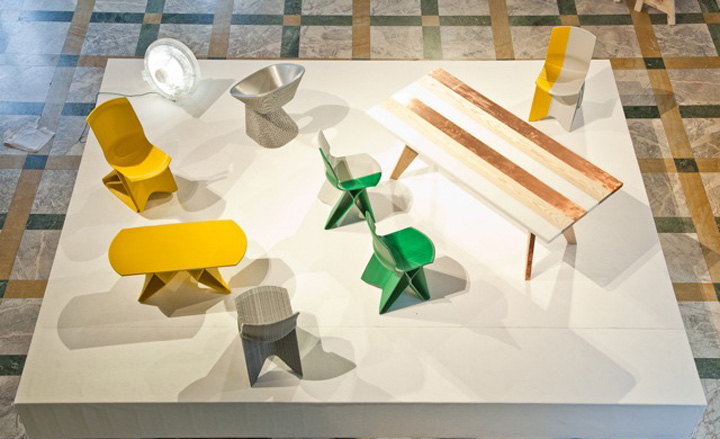
A selection of Dirk Vander Kooij's 'Endless' 3D printed furniture made, and available for sale, on site during the show.
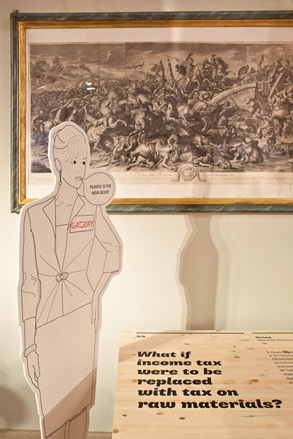
Droog introduced an interesting concept for an alternative furniture fair that was based on an new economic model that would tax materials and waste rather than income
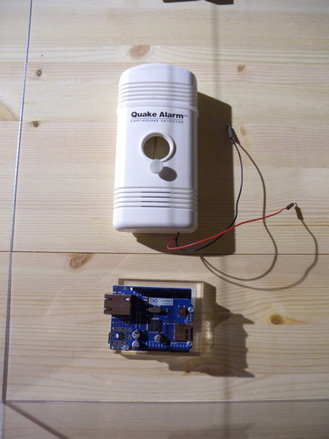
A 14 year old boy in Chile, Sebastián Alegría, has come up with an effective and cheap earthquake advanced warning system that works via Twitter, based on a piece of open-source hardware called an Arduino
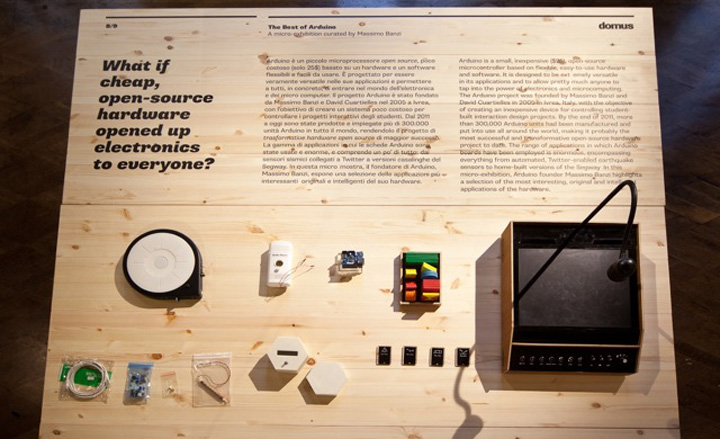
More open-source Arduino projects in a micro exhibition within the show, curated by engineer and Arduino-founder Massimo Banzi
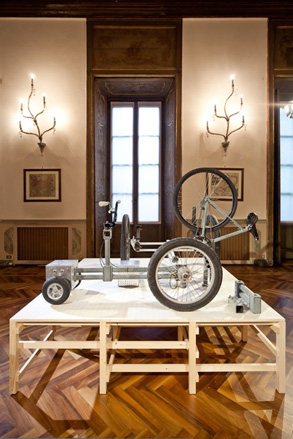
Open-structure bike project illustrating a modular construction system that allows consumers to build anything from bikes to houses, instigated by Belgian designer Thomas Lommée
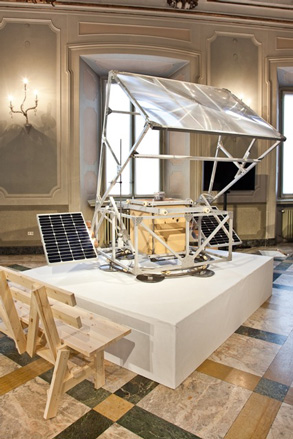
The amazing SolarSinter machine by RCA graduate Markus Keyser 'prints' objects out of sand using solar power
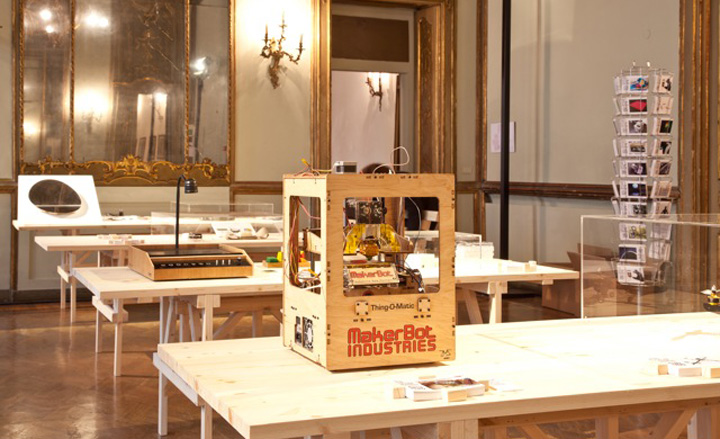
MakerBot Industries is a New York-based company producing open source hardware such as 3D printers
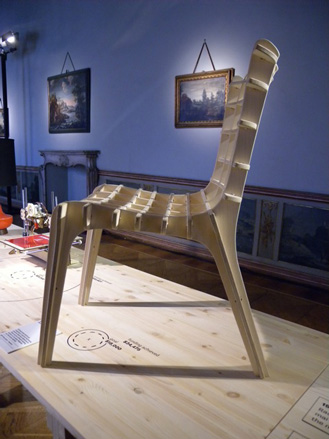
'Sketch Chair' developed with funding from Kickstarter.com, the world's largest crowdfunding platform for creative projects
Wallpaper* Newsletter
Receive our daily digest of inspiration, escapism and design stories from around the world direct to your inbox.
-
 Japan in Milan! See the highlights of Japanese design at Milan Design Week 2025
Japan in Milan! See the highlights of Japanese design at Milan Design Week 2025At Milan Design Week 2025 Japanese craftsmanship was a front runner with an array of projects in the spotlight. Here are some of our highlights
By Danielle Demetriou
-
 Tour the best contemporary tea houses around the world
Tour the best contemporary tea houses around the worldCelebrate the world’s most unique tea houses, from Melbourne to Stockholm, with a new book by Wallpaper’s Léa Teuscher
By Léa Teuscher
-
 ‘Humour is foundational’: artist Ella Kruglyanskaya on painting as a ‘highly questionable’ pursuit
‘Humour is foundational’: artist Ella Kruglyanskaya on painting as a ‘highly questionable’ pursuitElla Kruglyanskaya’s exhibition, ‘Shadows’ at Thomas Dane Gallery, is the first in a series of three this year, with openings in Basel and New York to follow
By Hannah Silver
-
 Eight designers to know from Rossana Orlandi Gallery’s Milan Design Week 2025 exhibition
Eight designers to know from Rossana Orlandi Gallery’s Milan Design Week 2025 exhibitionWallpaper’s highlights from the mega-exhibition at Rossana Orlandi Gallery include some of the most compelling names in design today
By Anna Solomon
-
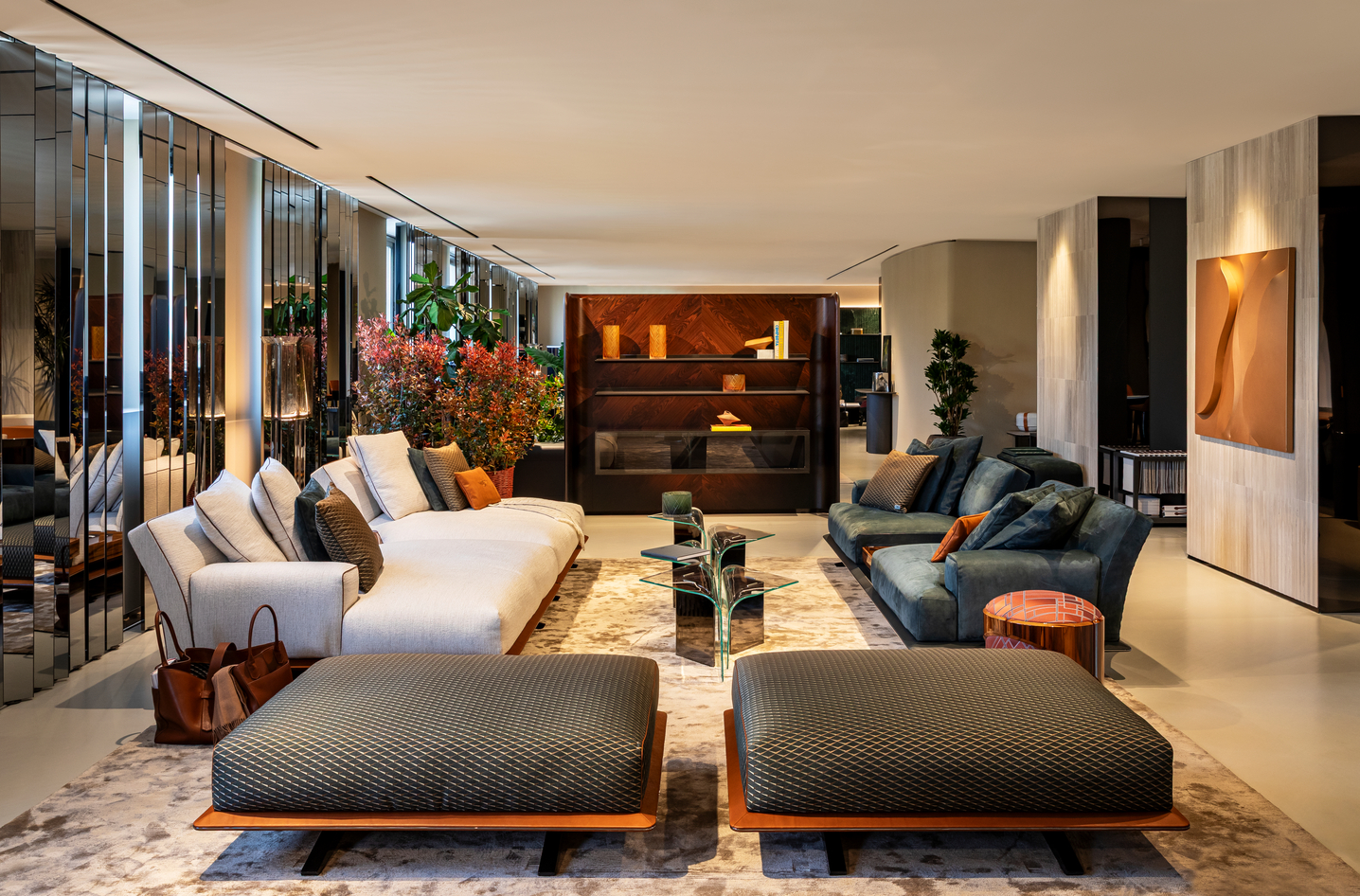 Bentley’s new home collections bring the ‘potency’ of its cars to Milan Design Week
Bentley’s new home collections bring the ‘potency’ of its cars to Milan Design WeekNew furniture, accessories and picnic pieces from Bentley Home take cues from the bold lines and smooth curves of Bentley Motors
By Anna Solomon
-
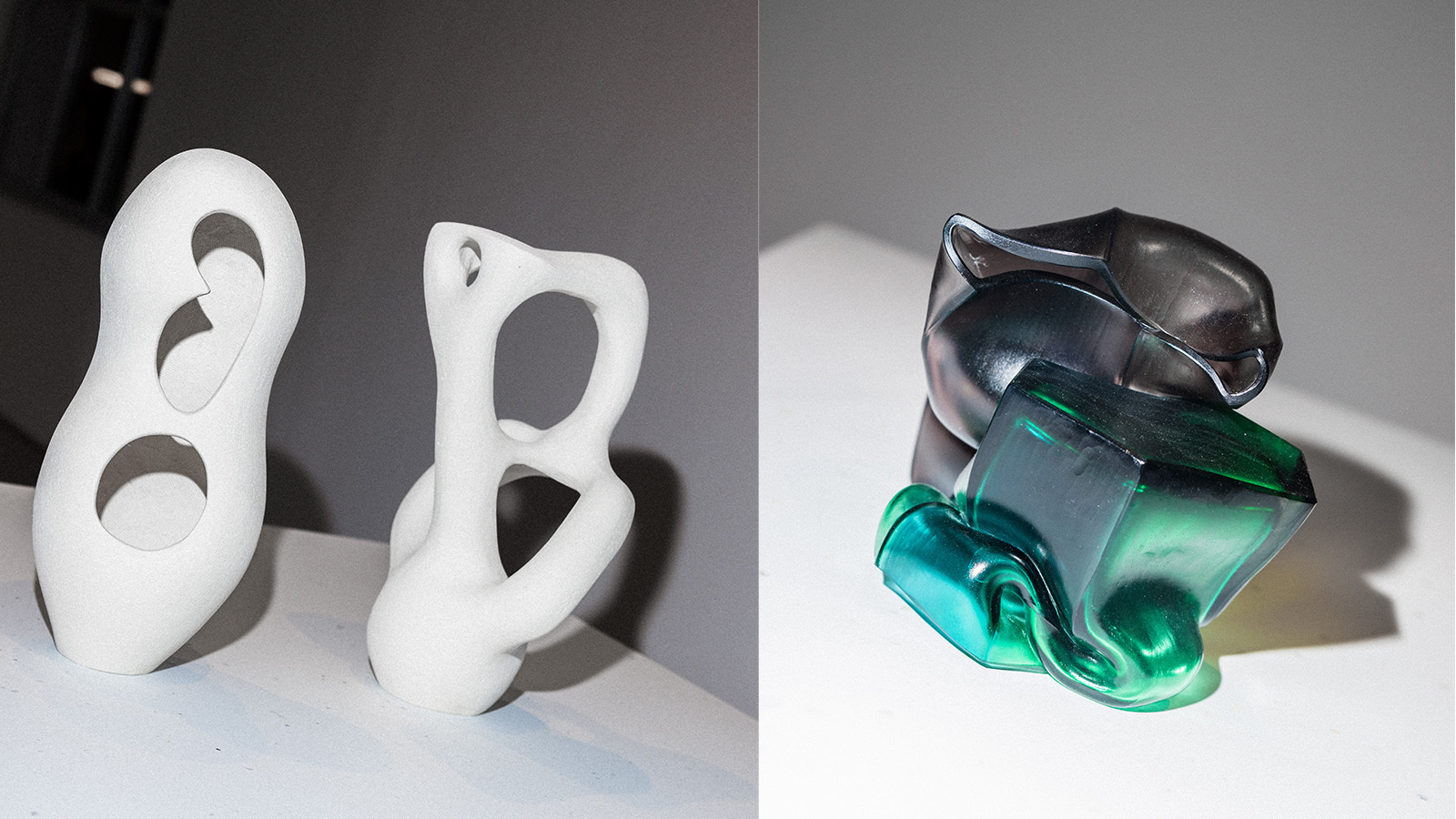 StoneX partners with Wallpaper* for material alchemy at Milan Design Week and beyond
StoneX partners with Wallpaper* for material alchemy at Milan Design Week and beyondThe natural stone purveyor teams up with Wallpaper* for a three-year partnership of material adventures, starting with an exhibition at Triennale di Milano
By Simon Mills
-
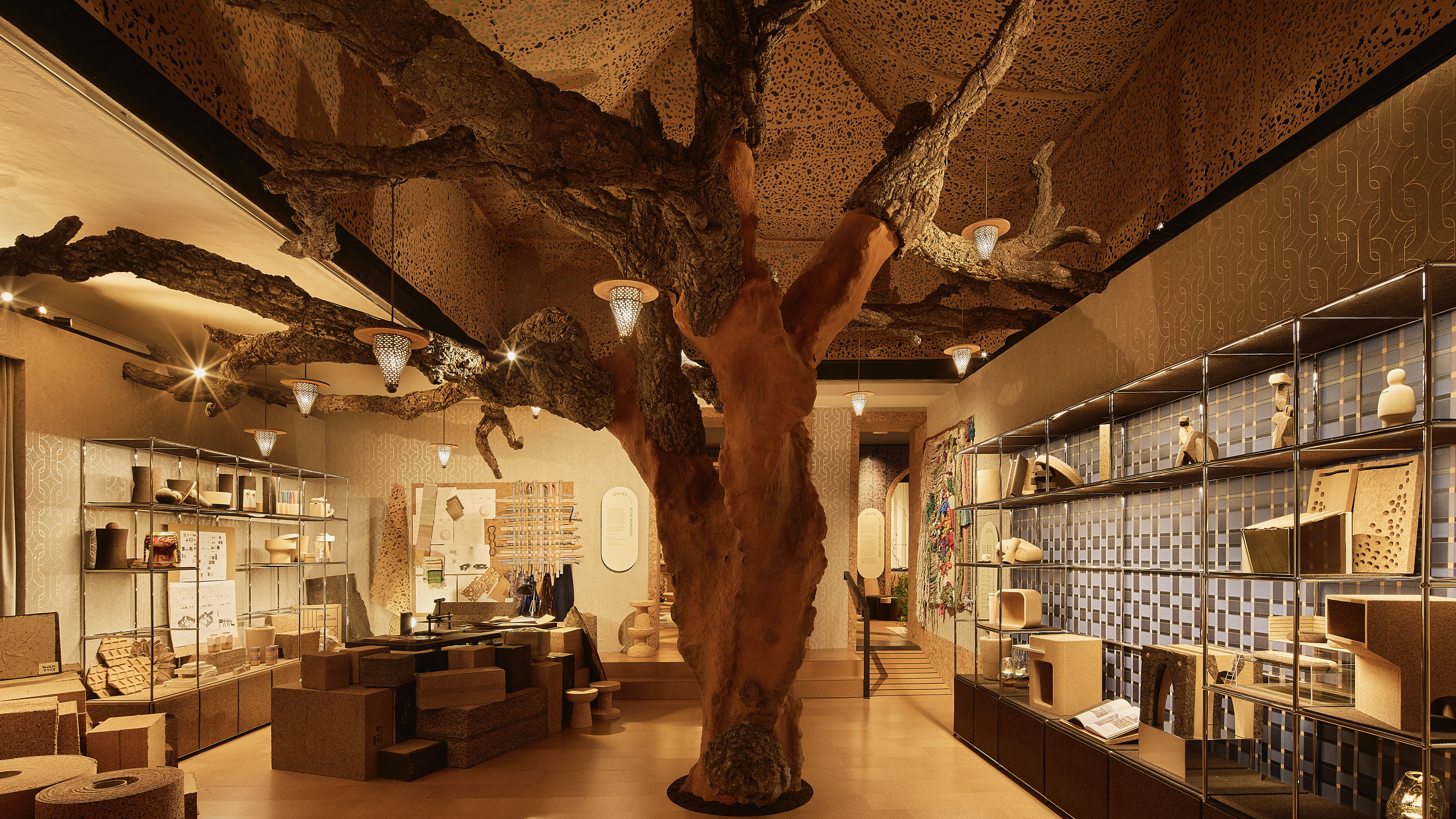 David Rockwell’s Milan Design Week presentation is a love letter to cork
David Rockwell’s Milan Design Week presentation is a love letter to corkRockwell Group’s Casa Cork installation showcases this under-appreciated material, which is infinitely recyclable and sequesters carbon for decades
By Anna Solomon
-
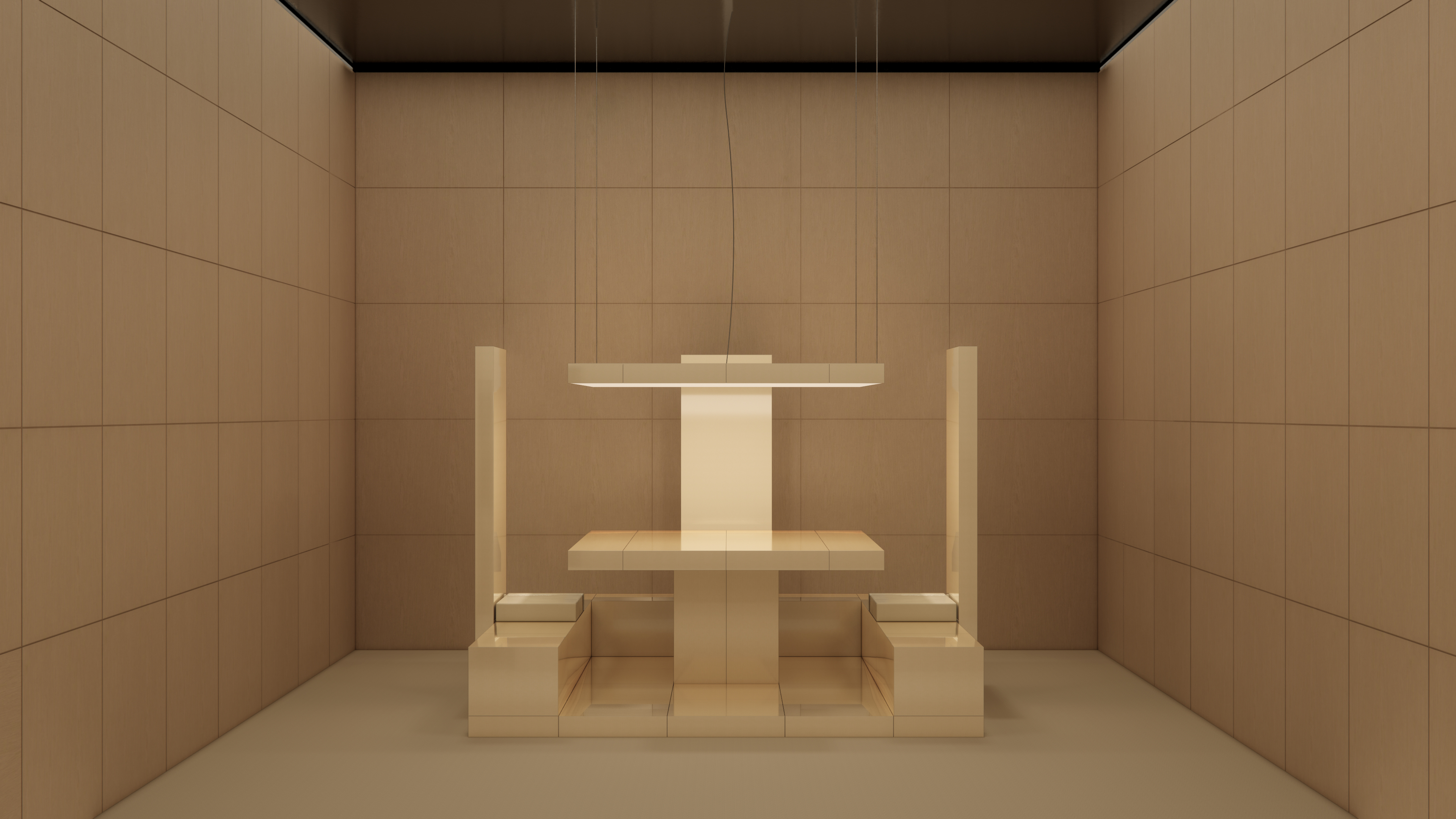 Emerging galleries to discover during Milan Design Week
Emerging galleries to discover during Milan Design WeekWallpaper’s Milan editor has the inside track on the younger design galleries coming to town
By Laura May Todd
-
 Buccellati brings the forest and Furry Animals to Milan Design Week
Buccellati brings the forest and Furry Animals to Milan Design WeekThe jewellery and silverware maison falls back on tradition for its Milan showcase, presenting its now-emblematic collection of intricately crafted creatures
By Laura May Todd
-
 Where next for Salone del Mobile? Maria Porro on the future of the world’s biggest furniture fair
Where next for Salone del Mobile? Maria Porro on the future of the world’s biggest furniture fairAhead of Salone del Mobile 2025 in Milan, we sit down with its president to talk design, data and forging the event’s future in a fast-changing world
By Hugo Macdonald
-
 What to see at Milan Design Week 2025
What to see at Milan Design Week 2025A guide to some of the events the Wallpaper* team is checking out at Milan Design Week (7–13 April) – from public installations and major launches to standout venues and must-see exhibitions
By Hugo Macdonald